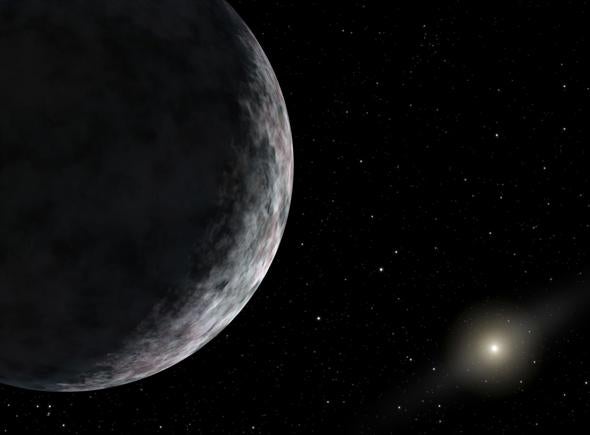A team of astronomers made something of a news splash late last week when they announced they have indirect evidence that there could be one or more massive planets orbiting in the solar system well beyond Neptune.
I read their journal paper, and their argument is certainly interesting (I’ll explain it in a sec). But let me be clear here: Their evidence of any possible planets out past Neptune is indirect (they don’t have photos or anything like that), it’s based on a small number of objects, and we do have evidence that there aren’t really big (like gas giant–sized) planets past Neptune. And it pains me to even have to bring this up, but of course this has nothing to do with Nibiru crackpottery, either.
Bottom line: To me, this is an interesting and potentially promising line of research, but right now it is quite inconclusive about the existence of planet-sized bodies past Neptune.
How this works isn’t that hard to understand in principle. (Note: After writing this but before posting it, I found that the AstroBites blog also discusses this topic, with more technical info.) In our solar system we have the Sun at the center, and it pretty much runs everything. It has 98 percent of the mass of the solar system, so its gravity is in charge of how everything else moves. BUT, there are also planets that have gravity as well. Their gravity is weak compared with the Sun’s but is strong enough that, given time, the planets can affect the orbits of other objects.
Out past Neptune is a region occupied by objects that are similar to asteroids but made of ice instead of metal and rock (making them more like comets, really). There are various names for them, but in general they’re called trans-Neptunian objects, or TNOs. Some are on circular orbits, some more elliptical, some have orbits tipped to the plane of the solar system, some don’t.
A handful, about a dozen discovered so far, have really weird orbits. They are highly elongated, and tipped significantly to the plane of the solar system. The authors of the study call them Extreme TNOs.
Their orbits are difficult to explain from what we know about the solar system now. However, the authors note that there is a comet called 96/P Machholz 1 that also has an odd orbit, which changes shape and orientation over time.* This is due to the influence of Jupiter; the comet’s orbit takes it out as far from the Sun as Jupiter’s orbit, so the huge planet pokes and prods the comet over time. This changes the comet’s orbit, making it undergo all sorts of peculiar behavior.
The authors then speculate that the weird TNOs may be explainable in a similar way. The TNOs fall into four groups according to distance, implying a series of planets at distances ranging from 40 to 150 billion kilometers from the Sun. (For comparison, Neptune is about 4.5 billion km out.) They don’t give specifics about the possible masses these planets would need, except to say they would need “at least several Earth masses” to affect the TNOs.
Again, the evidence they present is interesting, maybe even compelling, but it by no means is proof. They only look at the orbital characteristics of about a dozen extreme TNOs, and it’s hard to extrapolate safely from that. It seems clear something odd is going on, but the mechanism behind it isn’t clear. Planets? Maybe. But it could be something else.
I’ll note that a similar study was done with long period comets, which also found weird orbital characteristics that could be explained by a planet or planets past Neptune affecting their orbits. Unfortunately, this too relied on small number statistics and is interesting but not conclusive.
If these planets exist they can’t be too much bigger than Earth. Otherwise they’d have been seen by now; the NASA infrared survey observatory WISE has shown that no more Jupiter- or Saturn-sized planets can exist in our solar system, even way far out.
Personally, I’d love to have direct evidence of such planets. When I worked with Hubble, I spent some time trying to figure out ways of finding such planets! There’s no real theoretical reason they don’t exist, and we see evidence of planets orbiting other stars at great distances. So why not?
In the end, this research is perhaps motivation to keep looking. Even big planets would be terribly faint and difficult to detect at 150 billion km, so it may be quite a while before we have a confidently complete survey of the solar system. And even if they don’t exist, I’m glad people are still thinking about things like this. It’s best in science not to get too complacent with the “current understanding.” Nature is tricky and a lot more clever than we are.
Correction, Jan. 28, 2015: I originally misstated that comet Machholz 1 orbits the Sun retrograde, but it moves prograde, in the same direction as the planets. Its orbit changes, and may one day become retrograde, but that day is not yet here.
